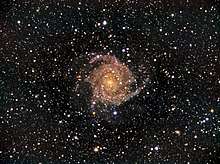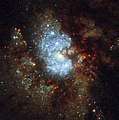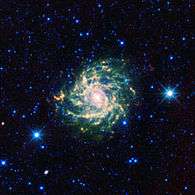IC 342
IC 342 (also known as Caldwell 5) is an intermediate spiral galaxy in the constellation Camelopardalis, located relatively close to the Milky Way. Despite its size and actual brightness, its location in dusty areas near the galactic equator makes it difficult to observe, leading to the nickname "The Hidden Galaxy",[4][1] though it can readily be detected even with binoculars.[5] If the galaxy were not obscured, it would be visible by naked eye. The dust makes it difficult to determine its precise distance; modern estimates range from about 7 Mly[6] to about 11 Mly.[2] The galaxy was discovered by William Frederick Denning in 1892.[7] It is one of the brightest in the IC 342/Maffei Group, one of the closest galaxy groups to the Local Group. Edwin Hubble first thought it to be in the Local Group, but it was later determined not to be a member.[8]
| IC 342 | |
|---|---|
 IC 342 imaged with a 102mm telescope. | |
| Observation data (J2000 epoch) | |
| Constellation | Camelopardalis |
| Right ascension | 03h 46m 48.5s[1] |
| Declination | +68° 05′ 46″[1] |
| Redshift | 31 ± 3 km/s[1] |
| Distance | 10.7 ± 0.9 Mly (3.3 ± 0.3 Mpc)[2][3] |
| Apparent magnitude (V) | 9.1[1] |
| Characteristics | |
| Type | SAB(rs)cd[1] |
| Number of stars | 100 billion |
| Apparent size (V) | 21′.4 × 20′.9[1] |
| Other designations | |
| UGC 2847, PGC 13826,[1] Caldwell 5 | |
In 1935, Harlow Shapley found that it was wider than the full moon, and by angular size the third-largest spiral galaxy then known, smaller only than the Andromeda Galaxy (M31) and the Triangulum Galaxy (M33).[9] (Modern estimates are more conservative, giving the apparent size as one-half to two-thirds the diameter of the full moon).[1][5]
It has an H II nucleus. The galaxy has a diameter of 75 000 light-years.[10]
Gallery
 IC 342, the "Hidden Galaxy." LRGBHa image by W4SM with 17" PlaneWave CDK
IC 342, the "Hidden Galaxy." LRGBHa image by W4SM with 17" PlaneWave CDK Hubble Space Telescope image of the central region of IC 342, showing the central star cluster and surrounding dust lanes.[4]
Hubble Space Telescope image of the central region of IC 342, showing the central star cluster and surrounding dust lanes.[4] IC 342 seen by the Spitzer Space Telescope
IC 342 seen by the Spitzer Space Telescope
See Also
- NGC 6946 - similar galaxy heavily obscured by Milky Way stars and dust.
References
- "NASA/IPAC Extragalactic Database". Results for IC 342. Retrieved 2006-11-01.
- I. D. Karachentsev; V. E. Karachentseva; W. K. Hutchmeier; D. I. Makarov (2004). "A Catalog of Neighboring Galaxies". Astronomical Journal. 127 (4): 2031–2068. Bibcode:2004AJ....127.2031K. doi:10.1086/382905.
- Karachentsev, I. D.; Kashibadze, O. G. (2006). "Masses of the local group and of the M81 group estimated from distortions in the local velocity field". Astrophysics. 49 (1): 3–18. Bibcode:2006Ap.....49....3K. doi:10.1007/s10511-006-0002-6.
- "Hubble's Hidden Galaxy". www.spacetelescope.org. Retrieved 3 July 2017.
- O'Meara, Stephen James (2002). The Caldwell Objects. Cambridge University Press. pp. 30–32. ISBN 0-933346-97-2.
- Nemiroff, R.; Bonnell, J., eds. (22 December 2010). "Hidden Galaxy IC 342". Astronomy Picture of the Day. NASA. Retrieved 28 January 2013.
- Denning, W. F. (1893). "New nebula". Astronomy and Astro-Physics. Bibcode:1893AstAp..12..189D.
- SEDS IC 342. Archived January 2, 2007, at the Wayback Machine
- Border Cities Star (Windsor, Ontario), "Spiral Galaxy Third Biggest", 24 June 1935, p.8
- Ho, Luis C.; Filippenko, Alexei V.; Sargent, Wallace L. W. (1997). "A Search for 'Dwarf' Seyfert Nuclei. III. Spectroscopic Parameters and Properties of the Host Galaxies". Astrophysical Journal Supplement. 112: 315. arXiv:astro-ph/9704107. Bibcode:1997ApJS..112..315H. doi:10.1086/313041.
External links
| Wikimedia Commons has media related to IC 342. |
- NASA Astronomy Picture of the Day – 22 December 2010
- IC 342 (image included)
- IC 342 on WikiSky: DSS2, SDSS, GALEX, IRAS, Hydrogen α, X-Ray, Astrophoto, Sky Map, Articles and images